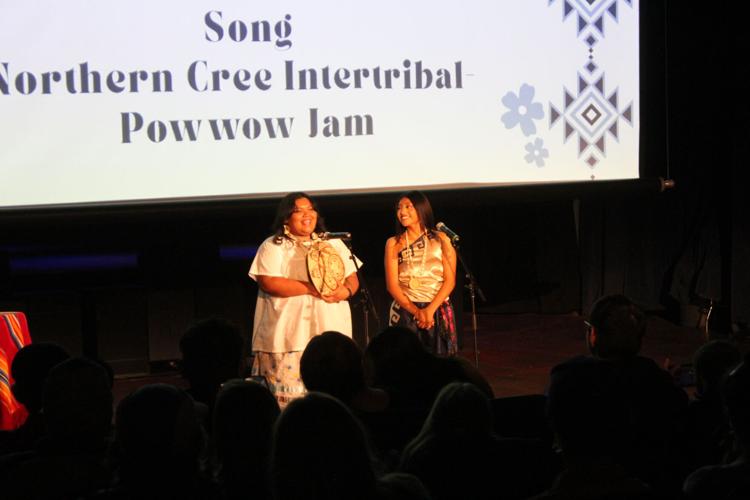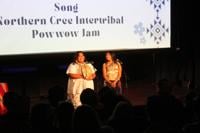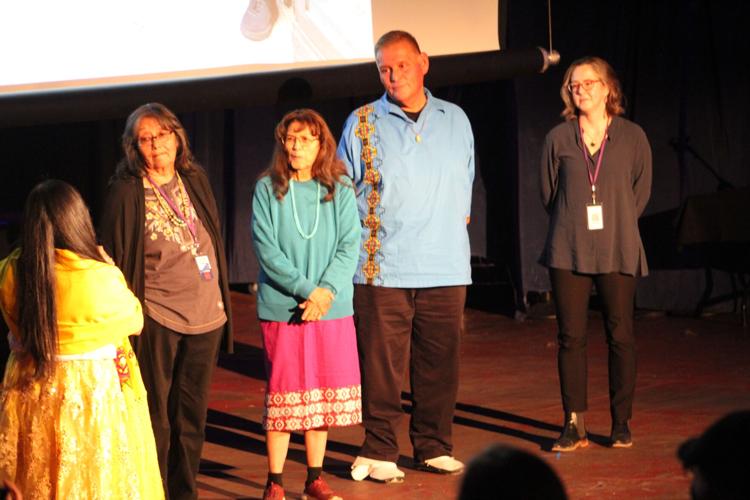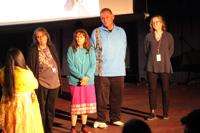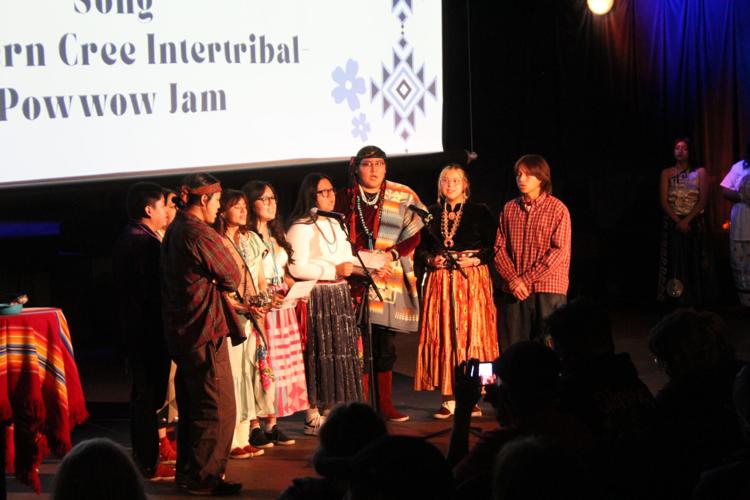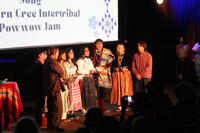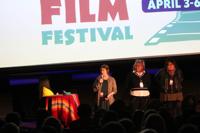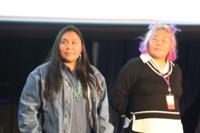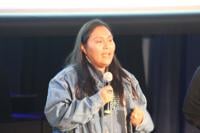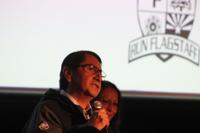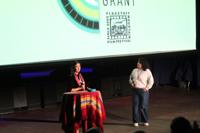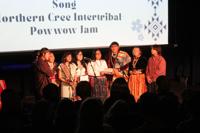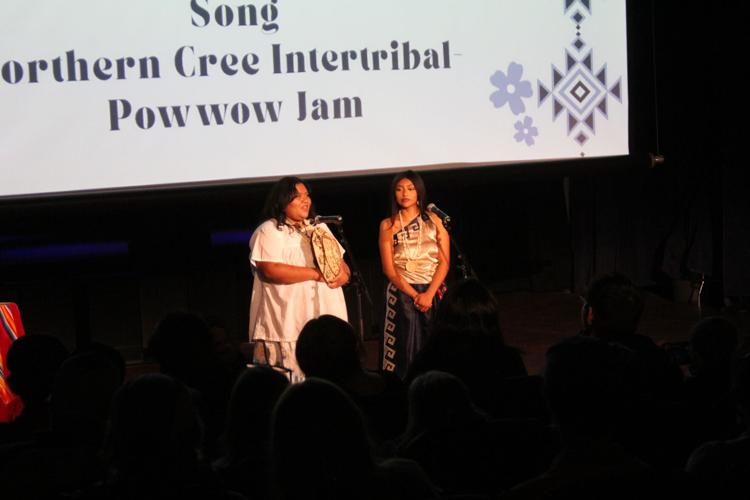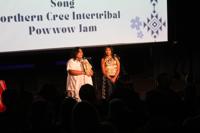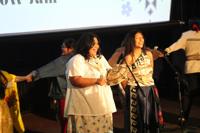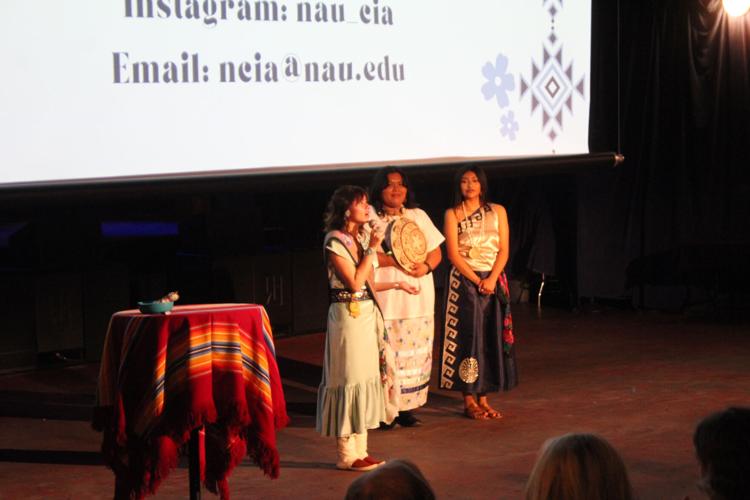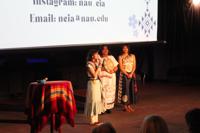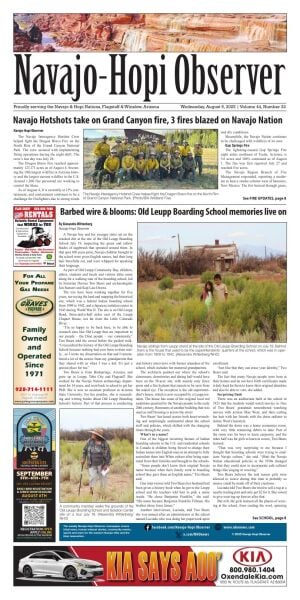The Flagstaff Mountain Film Festival held its annual Indigenous Voices session April 5 at a packed Orpheum Theater, where a variety of short Indigenous films were shown, along with an art market with creations by Diné, Hopi and Puebloan artists, and entertainment by Northern Arizona University’s Council of Indigenous Ambassadors.
The film festival is in its 23rd year, and executive director Montana Gia said they promoted the event more this year, causing the largest turnout yet.
Hopi Pottery: Connections Through Time

Hopi artists from the First Mesa spoke about their movie, “Hopi Pottery: Connections Through Time” after it screened at the Indigenous Voices showcase at the Flagstaff Mountain Film Festival April 5. (Alexandra Wittenberg/NHO)
This documentary showed the journey of Hopi artists Karen Charley, Larson Goldtooth, Darlene James, Valerie Kahe and Emmaline Naha as they traveled to witness historic Hopi pottery collections held at the American Museum of Natural History in New York City.
After the showing, the First Mesa potters told the audience they were thankful to the Andrew W. Mellon Foundation for giving them the opportunity to view their ancestors’ pottery.
James, a fifth generation potter, said she learned pottery from her grandmother, Rachel Namingha Nampeyo. She would go to her grandmother’s house after school, and what she thought was just “child’s play,” turned into her eventual career. She learned the long process of Hopi pottery creation around the age of 14, from looking for clay in the landscape, testing and processing, fixing spinach plants for the paint and chopping manure for the firing.
“To me it’s very important to talk to everyone about the pottery process so they can carry it on because we don’t want it to be lost,” James said.
Goldtooth, of the Hopi Tobacco clan and Navajo Deerwater clan, said they want to inspire younger people in the tribe to become interested in the art form in order to preserve it, and noted the education they were able to share through the platform of the documentary was powerful.
Navajo Nation: Reclaiming the Plate

Miss Navajo Nation 2022-2023 Valentina Clitso and Shelby Ray. (Alexandra Wittenberg/NHO)
This 11-minute documentary showcases former Navajo Nation President Jonathan Nez on a mission to heal his community by returning to traditional food and farming practices.
After the screening, Nez told the audience that they hope “Navajo Nation: Reclaiming the Plate” will turn into a segment for the Netflix documentary “Food 2.0.”
Nez shared his journey of going plant-based after being told he needed to make life changes at 300 pounds. He explained that for Indigenous people, being able to provide food for their own community is an important form of sovereignty.
“Legacy seeds that have been handed down from generation to generations are the most pure food you can have,” he said.
Nez’s wife, former Navajo Nation First Lady Phefelia Nez, added that “you have so much power when you can grow your own food and really get into the business of preparing your own foods,” along with knowledge of where it came from, storing it and harvesting.
Miss Navajo Nation 2022-2023 Valentina Clitso is featured briefly in the film running alongside Nez in her full regalia and crown, and also spoke to the audience about her personal health journey.
“During my time as Miss Navajo, that was probably my most unhealthy year I’ve ever had,” Clitso said. “It was days on end where I wouldn’t eat very much at all, maybe like one meal a day and there would be some days where I was butchering sheep every other day and would have unlimited mutton and buffets.”
Clitso shared that there’s not one right way to start your health journey.
“You see a lot of people, they want to get the most expensive attire, the right running shoes, the right shirt, the right shorts, and all of this high performing gear,” she said. “But you saw me in this film – I was wearing my traditional moccasins, maybe 50-plus pounds of traditional attire with my crown and everything just running through the sand and that’s what our people used to do.”

Former Navajo Nation President Jonathan Nez and Phefelia Nez spoke about Navajo Nation: Reclaiming the Plate” (Alexandra Wittenberg/NHO)
Kinlání Film Project
The students of Flagstaff High School’s Kinlání Dormitories created a 2-minute claymation. Each student animated a scene that reflected how the students see themselves, including their struggles, their lives and expectations. They also made a documentary about the film process, interviewing each other about their journeys as filmmakers and members of different Indigenous communities.
Diné filmmakers Deidre Peaches and Shelby Ray took to the Orpheum stage with Kinlání Film Project teacher Oakley Anderson-Moore to share their experience helping with the projects.
Ray explained that Peaches and herself had been making movies together since they were the students’ age.
“I think being able to use film and the acts of social media to be able to tell our stories is really important for us as Indigenous people because a lot of times our stories are not really told in mainstream media,” Ray said. “I think moving forward it’s important to help lift up the next generation to be very strong in their voice and who they are.”
Peaches and Ray also worked on “Navajo Nation: Reclaiming the Plate.” Peaches was field producer and Ray was a personal assistant.
Indigenous Filmmaker Grant

2024 Indigenous Filmmaker Grant Shonri Begay, right, is introduced. (Alexandra Wittenberg/NHO)
Shonri Begay was announced as the first recipient of the Flagstaff Mountain Film Festiva’s Indigenous Filmmaker Grant. Arizona Community Foundation and Mountain Sports contributed to the $1,500 grant which was made to inspire more Indigenous filmmakers. Begay is Tohono O’odham and Diné, and has a successful business, Three Sisters Bean Farm, where she grows Indigenous heirloom crops and teaches gardening to high school students. She has a bachelor’s of science in biomedical science and is now pursuing a master’s in communication.
“I’m in the beginning stages of exploring filmmaking,” Begay said. “I’m in a documentary film program at NAU that i’m really excited by.”
For the last year, Begay has been working with her father, well-known Diné painter Shonto Begay, to help translate her grandmother’s words for Begay’s project. A clip of the documentary was played at the festival, featuring the elder Begays.
“I’m going through a process of trying to understand my culture, especially through the matriarchs in my family,” Begay said. “This film is just exploring who she was through the filter of my father.”
The 2025 grant will be opening soon. Details will be available on flagstaffmountainfilms.org.


